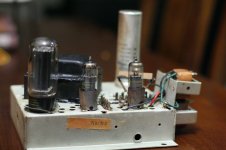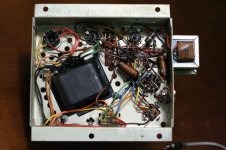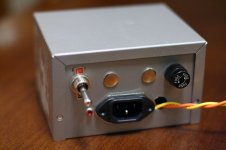I have some questions about an old Dumont / Emerson Console I recently acquired.
But first a little story that I’m sure many of you can relate to.
Last week was our annual city cleanup day. Once a year you can put just about anything out by the garbage can, and the city will haul it away for free. Well, you can guess what I spied in front of my neighbor’s house early that morning –an old tube console system. Sweet!
I asked the neighbor and he said it still worked and I was welcome to take it. While I carried it home, I sent my son ahead to open the garage. Apparently my wife asked what he was up to, and he spilled the beans that dad was on his way home with something snagged from the neighbors trash heap. Needles to say, my greeting at home was not exactly welcoming. She met me in the driveway, in her nightgown, and informed me that we do not need any more junk and now she will never be able to park in the garage. I understand the part about parking in the garage. But more junk? That implies that we already have junk. I don’t hang onto old junk, just the good stuff that I might need someday. I digress, but suffice it to say, I now have an old tube console to play with.
In actuality, this is my first tube amp. I’ve collected the parts for a Simple Single Ended, but haven’t started it yet.
I fired up the amp and sure enough it worked. It sounded OK, but I wasn’t too hopeful. For one thing, the output transformers are pretty small. Also, the amp has gotten hot and the power transformer had oozed black goo all over both the top and bottom of the amp. Luckily, this flaked off pretty easily, even from the tubes.
I then began the process of removing the amp from the system and figuring out how to make it work without the radio and phono preamp. Luckily I had the parts on hand as well as an enclosure I could use for a power input box. See, those old parts were not junk; I knew I would need them someday.
After I got the amp out, I started looking at the circuit. One thing that puzzled me was how voltage got from the power supply to the 12AX7 stage. All I can see is that it is routed from the UL taps on the output transformers. I have no experience with tube amps, but this doesn’t seem like a great idea to me. Am I missing something? Is this an acceptable way to power the first stage? By the way, the output tubes are EL84’s (6BQ5).
The voltage I measure at TP2 is about 290V, up from 284V. The voltage at TP1 started out at 285 volts when the amp was connected to the rest of the console. Now that the amp is disconnected from the radio and preamp, the voltage climbed to about 235V DC.
This brings up my second question. After listening to the amp for about 30 minutes last night, I noticed that one of the output tubes was glowing bright red! The other tube looks fine, but the glowing tube looked like it was about to explode. I’m thinking that the increased voltage is burning out the tube, but I have not yet learned how to calculate tube circuits. Do you think the increased voltage may be causing the problem?
One other voltage that seemed high was the heater voltage. It measured 7V on my Fluke DMM. The power transformer is stamped 117.5, so I assume that my wall voltage is causing the increased heater voltage. Do you think this will be a problem?
I guess the most important question is how did the amp sound? The answer is -surprisingly good. I connected it up the Saburos I built last year and put on some music. I listened to some female vocal, Josh Ritter, and Come Together by the Beatles. The amp easily handled the bass guitar and overall, sounded very good. It had a nice even tone and seemed more refined then I expected. I didn’t get a chance to see how loud it could go without distorting, but I did reach the ever present “turn that down, the kids are sleeping!” level.
Thanks for any comments and suggestions you may have.
Ben
But first a little story that I’m sure many of you can relate to.
Last week was our annual city cleanup day. Once a year you can put just about anything out by the garbage can, and the city will haul it away for free. Well, you can guess what I spied in front of my neighbor’s house early that morning –an old tube console system. Sweet!
I asked the neighbor and he said it still worked and I was welcome to take it. While I carried it home, I sent my son ahead to open the garage. Apparently my wife asked what he was up to, and he spilled the beans that dad was on his way home with something snagged from the neighbors trash heap. Needles to say, my greeting at home was not exactly welcoming. She met me in the driveway, in her nightgown, and informed me that we do not need any more junk and now she will never be able to park in the garage. I understand the part about parking in the garage. But more junk? That implies that we already have junk. I don’t hang onto old junk, just the good stuff that I might need someday. I digress, but suffice it to say, I now have an old tube console to play with.
In actuality, this is my first tube amp. I’ve collected the parts for a Simple Single Ended, but haven’t started it yet.
I fired up the amp and sure enough it worked. It sounded OK, but I wasn’t too hopeful. For one thing, the output transformers are pretty small. Also, the amp has gotten hot and the power transformer had oozed black goo all over both the top and bottom of the amp. Luckily, this flaked off pretty easily, even from the tubes.
I then began the process of removing the amp from the system and figuring out how to make it work without the radio and phono preamp. Luckily I had the parts on hand as well as an enclosure I could use for a power input box. See, those old parts were not junk; I knew I would need them someday.
After I got the amp out, I started looking at the circuit. One thing that puzzled me was how voltage got from the power supply to the 12AX7 stage. All I can see is that it is routed from the UL taps on the output transformers. I have no experience with tube amps, but this doesn’t seem like a great idea to me. Am I missing something? Is this an acceptable way to power the first stage? By the way, the output tubes are EL84’s (6BQ5).
The voltage I measure at TP2 is about 290V, up from 284V. The voltage at TP1 started out at 285 volts when the amp was connected to the rest of the console. Now that the amp is disconnected from the radio and preamp, the voltage climbed to about 235V DC.
This brings up my second question. After listening to the amp for about 30 minutes last night, I noticed that one of the output tubes was glowing bright red! The other tube looks fine, but the glowing tube looked like it was about to explode. I’m thinking that the increased voltage is burning out the tube, but I have not yet learned how to calculate tube circuits. Do you think the increased voltage may be causing the problem?
One other voltage that seemed high was the heater voltage. It measured 7V on my Fluke DMM. The power transformer is stamped 117.5, so I assume that my wall voltage is causing the increased heater voltage. Do you think this will be a problem?
I guess the most important question is how did the amp sound? The answer is -surprisingly good. I connected it up the Saburos I built last year and put on some music. I listened to some female vocal, Josh Ritter, and Come Together by the Beatles. The amp easily handled the bass guitar and overall, sounded very good. It had a nice even tone and seemed more refined then I expected. I didn’t get a chance to see how loud it could go without distorting, but I did reach the ever present “turn that down, the kids are sleeping!” level.
Thanks for any comments and suggestions you may have.
Ben
Attachments
All electrolytics and coupling caps need to be replaced before you go any further. A bad coupling cap is why the output tube is glowing. Consider yourself lucky that nothing worse happened. 
Can you post a scan or similar of your schematic?

Can you post a scan or similar of your schematic?
Those aren't UL taps - they're on the OPPOSITE side of the B+ terminal... which you can verify with an ohmmeter. They serve for hum cancellation - it saved adding an extra filter section in the power supply. A common trick in small SE amps from the '50s - radios seldom used this, since the 4" speakers couldn't reproduce 60 Hz anyway...
Did you draw that schematic by tracing the wiring? What you may have there is a hum bucking opt rather than an UL. I had a console that used that technique. What they did is run the power B+ into a tap partway down the winding rather than at one end then took power for the plate from the end of the longer winding and the power for the screen from the end of the shorter winding (and then on to the preamp stage). So it was actually pentode mode.
Thus they got some magnetic cancellation of hum and could use simpler (cheaper) PS filtering.
Thus they got some magnetic cancellation of hum and could use simpler (cheaper) PS filtering.
I did draw the schematic by tracing wires. I just assumed that since there were five wires coming out of the OPT they must be UL taps. What you and Tom describes makes more sense and solves the power supply problem I couldn't figure out. I will check it out tonight.
Thanks,
Ben
Thanks,
Ben
- Status
- Not open for further replies.


